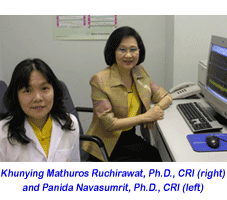New Study Links Changes in Gene Expression in Infants to Arsenic Exposure
CRI-MIT Collaborative Study
In a collaborative study, researchers at the Chulabhorn Research Institute (CRI) in Thailand and of the Massachusetts Institute of Technology (MIT) in the United States have found that the children of mothers exposed to water supplies contaminated with arsenic during their pregnancies showed gene expression changes that could lead to cancer and other diseases later in life, even if the children themselves were never directly exposed to arsenic.
The new study, in establishing the potential harmful effects of prenatal exposures, provides a possible method of screening populations to detect signs of arsenic contamination. Moreover, it is the first study to provide evidence of genome-wide changes resulting from prenatal exposure from any environmental contaminant.
Arsenic contamination is a health concern worldwide with millions exposed to levels that exceed the World Health Organization (WHO) safety standard of 10 parts per billion (ppb). The element was classified as a Group 1 carcinogen by the International Agency for Research on Cancer (IARC) and has been implicated in such diseases as vascular disorders and diabetes.
The CRI research team included HRH Princess Chulabhorn Mahidol, President of CRI, and Mathuros Ruchirawat, Vice President for Research (CRI), in Bangkok, working with Leona Samson, director of the MIT Center for Environmental Health Sciences and Rebecca Fry, a research scientist at the Center.


|
The investigators recruited 32 healthy, pregnant women between the ages of 20 and 40 for the study. Twenty three of the women lived in the Ron Pibul District of southern Thailand in villages that had been classified as high-level arsenic contaminated areas as a result of extensive tin mining from the 1960s to 1980s. Levels of arsenic in groundwater in the area are as much as 50 times the WHO standard. Women with toenail arsenic levels representing exposure below the WHO limit of 10 ppb served as a control group.
During the subjects’ pregnancies, the CRI investigators collected toenail samples, which were analyzed for total arsenic concentrations that reflect past exposures. After delivery of the women’s children, a sample of newborn cord blood was collected for microarray analysis of gene expression.
The researchers then performed data analysis to identify genes that showed modulated expression as a result of prenatal exposure and also to determine transcription factor binding sites and molecular interactions.
Microarray analysis identified approximately 450 genes that were differentially expressed between the two populations, 90 percent of them showing an increase in expression level. The investigators were able to isolate three arsenic-associated gene expression signatures and found that even the smallest set, which included eleven genes, showed 83 percent accuracy in predicting prenatal arsenic exposure. The eleven genes fall into gene ontology categories related to cell growth and death, stress and immune response, and inflammation.
This study underscores that there is a robust prenatal response that correlates with arsenic-exposure levels that could modulate numerous biological pathways including apoptosis, cell signaling, the inflammatory response, and other stress responses, and ultimately affect health status. Arsenic contamination of the drinking water in the Ron Pibul area of Thailand is representative of that seen in many other areas of South East Asia, most notably Bangladesh, suggesting that prenatal exposures are likely to be endemic in these areas. Moreover, arsenic contamination of the Ron Pibul drinking water is roughly the same as that known to be present in many of the western United States, suggesting that prenatal arsenic exposure may also be a problem in the United States. These data contribute to our understanding of biological responses upon arsenic exposure, and show that prenatal exposure in human results in measurable phenotypic responses in the newborn.
This research study was chosen to be among the fifteen top papers to come out of NIEHS in 2007.
Source:
- Fry RC, Navasumrit P, Valiathan C, Svensson JP, Hogan BJ, Luo M, Bhattacharya S, Kandjanapa K, Soontararuks S, Nookabkaew S, Mahidol C, Ruchirawat M, Samson LD. Activation of Inflammation/NF-κB Signaling in Infants Born to Arsenic-Exposed Mothers. PLoS Genetics, November 2007
posted on May 20, 2008
